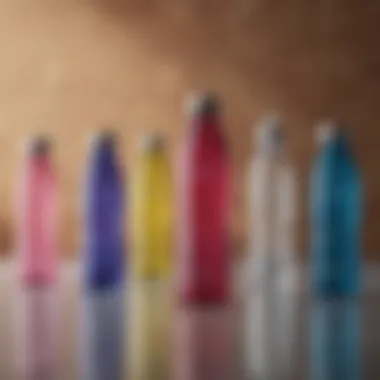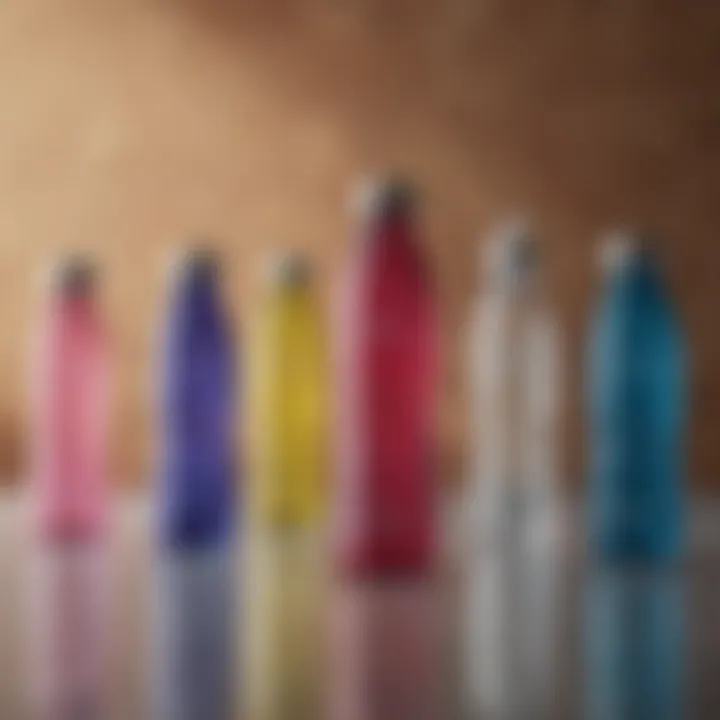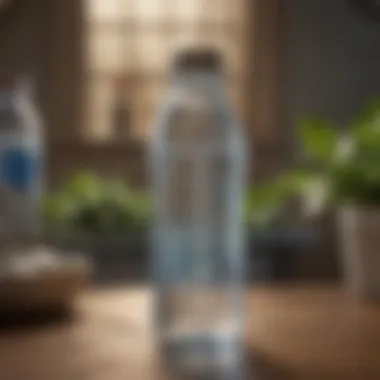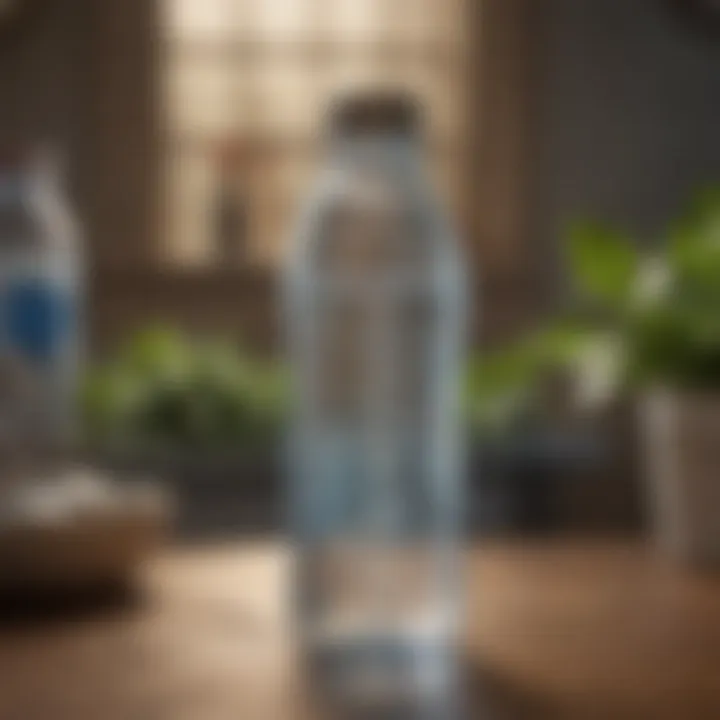Enhance Your Hydration Habits with Water Bottles


Intro
Water is a fundamental component of human health. Yet, many individuals struggle to maintain adequate hydration levels throughout the day. The relationship between water consumption and water bottles goes beyond mere convenience. When used effectively, specific water bottle designs can serve as powerful tools to encourage better hydration habits. This article will explore various aspects of this relationship, covering the types of water bottles available, their design features, and practical tips for enhancing daily hydration practices.
Understanding Water Bottles
Types of Water Bottles
There is a diverse array of water bottles on the market today. Some common types include:
- Plastic Water Bottles: Often lightweight and portable, these are popular for everyday use but can have issues with durability and environmental impact.
- Stainless Steel Bottles: Known for insulation properties, they keep drinks cold or hot for extended periods. They’re also more sustainable compared to plastic.
- Glass Water Bottles: These offer a pure taste and are free from chemicals found in some plastics. However, they can be heavier and more fragile.
- Infuser Bottles: These allow users to add fruits or herbs to water, enhancing flavor and motivation to drink more.
Key Design Features
Different designs enhance usability. Key features often include:
- Sip Tops: Allow for easy drinking on the go without spills.
- Handles: Provide better grip and portability.
- Measurement Markings: Help track water intake easily.
Motiviation to Drink More Water
Utilizing a water bottle that aligns with personal preferences can boost motivation. When a bottle is appealing, convenient, and functional, individuals might find themselves reaching for it more often. This often translates into higher water consumption throughout the day.
Practical Tips for Improved Hydration
- Set Reminders: Use phone alarms to prompt drinking at regular intervals.
- Carry it Everywhere: Make the water bottle a constant companion, whether at home, office, or out.
- Personalize Your Bottle: Add stickers or choose a color that you love to make it more inviting.
- Hydration Goals: Set daily water intake goals and measure progress using a marked water bottle.
"Small consistent changes can make significant impacts on overall hydration habits."
Environmental Considerations
Using reusable water bottles contributes to reducing plastic waste. The impact of single-use plastic bottles on the environment is substantial. Therefore, choosing a reusable option supports sustainability.
Finale
Incorporating water bottles into daily routines can significantly boost hydration habits. By understanding the available options and utilizing practical tips, individuals can improve their water intake effectively. This conscious effort towards hydration can lead to better health outcomes and a more sustainable lifestyle.
Understanding Hydration Needs
In the quest for optimal health, hydration is one of the most fundamental aspects to consider. Understanding hydration needs helps individuals make informed choices regarding their water intake. This section explores the necessity of hydration, how much water one should typically consume, and the warning signs alerting us to dehydration.
The Importance of Staying Hydrated
Adequate hydration plays a pivotal role in ensuring the body operates smoothly. Water is essential for regulating body temperature, lubricating joints, and maintaining overall bodily functions. The human body is composed of about 60% water, and it is essential for nutrient transport and waste elimination. If hydration levels drop, even slightly, physical and cognitive performance can be affected negatively. Research indicates that hydration has a significant impact on energy levels and mood as well.
Daily Water Intake Recommendations
Determining the right amount of water to drink each day requires consideration of various factors such as age, weight, activity level, and climate. The often-cited guideline is to drink about 2 liters (or half a gallon) of water per day. However, this can vary. A more personalized approach may be to drink about 30-35 milliliters of water per kilogram of body weight. For example, an individual weighing 70 kilograms should aim for approximately 2.1 to 2.45 liters of water daily. Moreover, those engaging in physical activity or residing in hotter climates should increase their intake to compensate for fluid loss.


Signs of Dehydration
Recognizing the signs of dehydration is crucial for maintaining optimal hydration. Common symptoms include:
- Thirst
- Dry mouth
- Fatigue
- Dizziness
- Dark yellow urine
In severe cases, dehydration can lead to more serious health issues such as kidney stones or urinary tract infections. It's advisable for individuals to pay attention to these signs and adjust water consumption as necessary. By prioritizing hydration and understanding its importance, individuals can enhance their overall health and well-being.
Choosing the Right Water Bottle
Selecting an appropriate water bottle is critical to developing and maintaining effective hydration habits. A well-chosen water bottle not only encourages more frequent drinking but also ensures that the water remains safe, fresh, and appealing. Considering the diverse options available, understanding the key features of different types of bottles is essential for making enlightened decisions. The right bottle aligns with personal preferences, lifestyle, and environmental considerations, thereby facilitating healthier habits.
Materials Used in Water Bottles
The choice of materials significantly influences the usability and safety of your water bottle. Common materials include plastic, glass, and stainless steel—all offering distinct advantages and disadvantages.
Plastic
Plastic is perhaps the most prevalent material for water bottles. Its main characteristic is lightweight and its high durability. People often choose plastic bottles for their affordability and convenience. However, not all plastics are created equal. BPA-free options are essential to eliminate the risk of harmful chemicals leaching into the water.
A unique feature of plastic is its variety of designs and colors. Many plastic bottles come with adjustable straws or flip lids, making them easy to use on the go. Nevertheless, plastic bottles do have disadvantages, such as their potential for retaining odors and scratches over time. Additionally, concerns about plastic waste and environmental impact prompt a growing number of consumers to seek alternatives.
Glass
Glass bottles are favored for their purity and lack of chemicals. The key characteristic of glass is its ability to keep water tasting fresh. Many people appreciate how glass does not retain or impart flavors, making it a beneficial choice for those sensitive to taste.
The unique feature of glass is its aesthetically pleasing appearance, often available in stylish designs that appeal to a wide audience. Unfortunately, glass can be prone to breakage, limiting its use in some environments, such as those involving strenuous outdoor activities.
Stainless Steel
Stainless steel represents another robust option, known for its durability and insulation properties. It keeps beverages cold or hot for extended periods, making it an ideal choice for both cold water and hot beverages. The key characteristic of stainless steel is its resistance to rust and corrosion, ensuring long-lasting utility.
Many users prefer stainless steel for its eco-friendliness, as it can be reused numerous times without losing its integrity. However, they can be heavier than plastic options, which may be a consideration for portability. Additionally, some people may find the price point of stainless steel bottles higher than that of plastic.
Bottle Size and Capacity Considerations
When selecting a water bottle, size and capacity are paramount. Smaller bottles are easier to carry but require more frequent refills, while larger bottles ensure adequate hydration with less effort. Finding the right balance will enhance convenience and encourage usability throughout the day. It's essential to evaluate your hydration habits, physical activity levels, and water needs when making a decision.
Design Features That Encourage Hydration
The design of a water bottle significantly impacts your hydration practice. Features such as mouth style, infusion capability, and measurement markings contribute to how appealing and functional a bottle can be.
Straw vs. Wide Mouth
The choice between a straw and wide mouth opening can affect how easily you drink water. Straws are often easier for quick sips, while wide mouth openings facilitate cleaning and filling. This feature suits those who want to add ice or fruit slices conveniently. However, wide mouths may lead to spills during transport, so individuals must consider their specific usage scenarios.
Built-in Infusers


Built-in infusers allow users to flavor their water naturally by adding fruits or herbs. This feature can promote greater hydration, as flavored water may be more appealing than plain water. For people seeking to intake more fluids, a water bottle with this innovation can be a game-changer. However, they require regular cleaning to maintain hygiene and prevent mold growth.
Measurement Markings
Measurement markings can provide a visual guide to track water intake throughout the day. Having clear indicators helps individuals monitor their hydration goals effectively. This feature is beneficial for fitness enthusiasts or anyone striving to drink more water regularly. However, markings may fade over time, making regular checks important for maintaining accuracy.
In summary, when choosing a water bottle, material, size, and design features play an essential role in determining its effectiveness in promoting hydration habits. Taking the time to consider these factors can lead to improved health outcomes and a more consistent approach to staying hydrated.
Innovative Water Bottle Designs
Water bottles have evolved significantly over the years. The innovative designs available today not only serve to hold water, but they also play a vital role in promoting better hydration habits. These bottles incorporate various features that enhance user experience, convenience, and efficiency.
Some benefits of innovative water bottle designs include their ability to cater to different lifestyles. For instance, some people prefer bottles with smart technology that tracks water intake. Others may benefit from sustainable materials that reduce environmental impact. The design can also directly influence how often an individual reaches for their bottle throughout the day.
Smart Water Bottles
Smart water bottles are an intriguing advancement in the hydration space. Equipped with technology, these bottles can measure the amount of water consumed and remind users to drink more regularly. Many are compatible with smartphone apps, allowing users to set specific hydration goals. For example, a user might aim to drink two liters of water daily.
Some smart bottles, like the HidrateSpark, use light notifications to signal when it is time to drink. Thus, by utilizing new technology, individuals keep hydration as a priority in their busy lives. Smart bottles can also sync with fitness trackers, combining exercise data with hydration needs.
Self-Cleaning Bottles
Self-cleaning water bottles represent another innovative design that addresses hygiene concerns. Bottles such as the LARQ Bottle use ultraviolet light technology to eliminate bacteria and viruses inside and outside the bottle. The self-cleaning feature means users do not need to wash the bottle frequently, and it keeps the water tasting fresh. As more people become aware of health issues related to germs and bacteria, self-cleaning options become increasingly attractive. This design feature can simplify maintaining health standards and encourage regular use of the bottle.
Eco-Friendly Options
Eco-friendly water bottles are another way to merge functionality with environmental responsibility. Brands like CamelBak focus on using materials that minimize environmental impact. These include BPA-free plastics and recyclable metals.
Investing in a reusable eco-friendly water bottle not only benefits the environment but also shapes positive hydration habits. It signifies a commitment to reducing single-use plastic waste. Moreover, consumers often feel a sense of satisfaction knowing that their product contributes to a healthier planet.
Creating a Routine to Drink More Water
Developing a habit of drinking sufficient water throughout the day can significantly enhance overall health. Creating a routine to drink more water helps to ensure that hydration becomes second nature rather than a once-in-a-while effort. It may be useful to integrate water consumption into the daily schedule, contributing to better health outcomes, enhanced cognitive function, and increased energy levels. Moreover, the routine creates a structured approach which is easier to follow.
Setting Reminders
One effective way to develop a hydration routine is by setting reminders throughout the day. This could be accomplished using smartphone apps or physical timers. Such reminders help to create a mental cue that prompts the individual to drink water regularly. In busy moments, it’s easy to forget to hydrate. By establishing a habit with reminders, it reduces the chance of falling short on daily water intake needs. Regular reminders can also create an association between activities and the act of drinking water, reinforcing the behavior.
Integrating Hydration into Daily Activities
While Working
While working, hydration often takes a back seat to looming deadlines or demanding tasks. This makes it crucial to incorporate water breaks into the work routine. Having a water bottle on the desk serves as a prompt to drink water. Refilling it periodically reinforces the idea of consuming fluids. Additionally, an easily accessible water source at the workplace aids in maintaining regular hydration. It has been noted that staying hydrated while working can lead to improved concentration and reduced fatigue.
During Exercise
During exercise, the importance of hydration cannot be overstated. Engaging in physical activity causes the body to lose fluids, which must be replenished to maintain performance and prevent dehydration. A water bottle specifically designed for workouts, with features to prevent spills, allows easy access to hydration during sessions. This not only supports physical performance but also encourages a habit of drinking water before, during, and after workouts, making it a vital part of any fitness routine.


Social Events
Social events often present an opportunity for hydration, yet there can be a tendency to overlook water amidst the festivities. Bringing a personal water bottle to gatherings can help keep hydration on the agenda. Moreover, refilling a bottle while socializing is an easy way to ensure that drinking water remains a part of the experience. It serves as a reminder that hydration should not be neglected despite the social environment. This approach promotes conscious water consumption and encourages others to follow suit, creating a more health-focused atmosphere.
Tracking Water Intake
The Environmental Impact of Water Bottles
The use of water bottles has become integral to modern hydration practices. However, many individuals overlook the environmental implications of their choices. This section examines how water bottles, particularly single-use plastics, contribute to environmental degradation. It conveys the necessity of mindful consumption and demonstrates how certain alternatives can positively impact sustainability efforts.
Plastic Waste Concerns
Plastic waste remains one of the foremost challenges facing our planet. Most plastic water bottles are used just once before being discarded. This leads to millions of tons of plastic pollution that adversely affects marine life and ecosystems. Plastic bottles take hundreds of years to decompose, creating long-lasting harm in our environment.
An alarming number of plastic bottles are found in oceans and landfills.
- According to estimates, about 1.5 million tons of plastic are directed to marine environments annually.
- Animals often mistake plastic for food, which can lead to suffocation and starvation.
Addressing these concerns requires a critical evaluation of how we approach hydration. Making conscious choices can result in significant shifts toward better environmental stewardship.
Benefits of Reusable Bottles
Transitioning to reusable water bottles presents numerous benefits. Firstly, they drastically reduce the amount of plastic waste produced daily. Using a reusable bottle not only helps clear landfills but also participates in a circular economy where materials can be recycled efficiently.
The advantages extend beyond environmental considerations. Reusable bottles can also be more economical in the long run, as they eliminate the continuous expense linked with purchasing single-use bottles. Furthermore, these bottles often offer functionalities, such as insulation, that enhance drinking experiences.
- Reusable bottles come in various materials like stainless steel, glass, and BPA-free plastic.
- They can be adorned with designs that reflect personal style, making hydration more appealing.
Sustainable Practices in Hydration
Emphasizing sustainable hydration practices is essential in reducing the environmental footprint of our daily habits. Here are methods to implement sustainable hydration:
- Opt for Reusables: Choose high-quality reusable bottles designed to last for years.
- Filter Water at Home: Utilize home filtration systems to reduce bottled water reliance.
- Participate in Recycling Programs: Recycle old bottles responsibly instead of tossing them in the trash.
- Stay Informed: Stay updated on local initiatives aimed at reducing plastic consumption and promoting recycling.
In summary, embracing a sustainable approach to hydration involves much more than merely refilling a bottle. It requires a commitment to understanding the broader implications of our choices and actively participating in environmental stewardship. By emphasizing the use of reusable bottles and integrating practical sustainable practices, individuals can significantly reduce their ecological impact while meeting their hydration needs.
Epilogue
The conclusion serves a pivotal role in tying together the various aspects discussed in the article. Its significance lies in emphasizing the relationship between water bottles and the enhancement of hydration habits. This section reiterates how a practical appreciation of water bottle functionalities can impact daily drinking behaviors.
Recap of Benefits
In reviewing the benefits discussed, it is evident that water bottles are more than mere containers. They can transform the act of drinking water into a regular and enjoyable practice. Some of the key benefits include:
- Convenience: Having a water bottle at hand makes it more likely to drink adequate amounts of water.
- Variety in Design: With different designs and features, individuals can find a bottle that suits their personal lifestyle and preferences.
- Environmental Benefits: Reusable bottles help to reduce plastic waste, promoting sustainable living.
- Tracking and Reminding: Many modern bottles come with functionalities that remind users to stay on track with their hydration goals.
"Understanding the elements that influence hydration can lead to better choices and healthier lifestyles."
Future Trends in Water Bottle Design
As we look ahead, several trends are emerging in water bottle design. Consumers increasingly demand products that reflect their lifestyles while being eco-conscious. Some anticipated future trends include:
- Smart Technology Integration: Expect more bottles with smart features that track hydration and provide real-time feedback.
- Biodegradable Materials: A shift towards using materials that are environmentally friendly and biodegradable may gain traction.
- Customization and Personalization: Personalized designs that cater to individual needs are likely to become more popular, allowing users to express their identity.
- Collaboration with Health Apps: Bottles that sync with health tracking apps may become standard, making hydration monitoring seamless.
In summary, the conclusion crystallizes the importance of utilizing water bottles as a tool for improving hydration habits. As innovations continue to emerge, staying informed allows users to make choices that best serve their hydration needs while motivating them to be proactive about their health.







